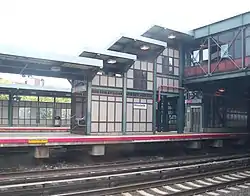Woodside station (LIRR)
Woodside is a station on the Long Island Rail Road's Main Line and Port Washington Branch in the Woodside neighborhood of Queens, New York City. It is the first station passed by eastward trains from Penn Station, and it is the only station in Queens shared by the Port Washington Branch and other LIRR branches. East of Woodside the two-track Port Washington Branch turns eastward, while the four-track Main Line continues southeast to Jamaica station.
Woodside has six tracks and three platforms. The four southernmost tracks passing through the station are the Main Line tracks; the two center tracks on the Main Line are through (express) tracks and do not have platform faces at Woodside. The two northernmost tracks are the Port Washington branch tracks, both of which have platforms. West of the station, the line merges with Amtrak's Hell Gate Bridge access tracks (part of the Northeast Corridor) at Harold Interlocking before entering the East River Tunnels to Manhattan. The 61st Street–Woodside (7 and <7> trains) station is above Woodside station, on a viaduct high above Roosevelt Avenue. The station is ADA-accessible via elevators and ramps.
History

Woodside originally had two railroad stations. One was built in 1861 on 60th Street by the LIRR subsidiary New York and Jamaica Railroad; the other, larger station was built by the Flushing and North Side Railroad on November 15, 1869, and was the first to be built by the F&NS after acquiring the troubled New York and Flushing Railroad.
For a short period during the 1870s, it served not only the Port Washington Branch but also the Woodside Branch. The Woodside Branch ran across northwestern Queens, had one station at Junction Boulevard and 35th Avenue, and took commuters either to the former Whitestone Branch or to what is today Corona Yard. Like all other stations on Long Island, it was acquired by the Long Island Railroad in 1876, but in this case the former LIRR-built station was abandoned.
Though the line was electrified on June 16, 1910, the station was closed in 1914 due to a grade elimination project and razed on November 17, 1915. The existing elevated station was opened on October 17, 1915. When Winfield station was closed in 1929, Woodside became the station for Main Line and Port Washington Branch trains before the split at Winfield Junction. A restoration project took place in 1999.
In 2006, an 18-year-old woman died after falling into the gap between the platform and train, and subsequently getting hit by an oncoming passenger train.[3][4] The death resulted in the LIRR and Metro-North Railroad implementing an aggressive platform gap mitigation[3]:7 platform conductor personnel, and "Watch the gap" programs.[5][6][3]:6
Station layout
This station has three 12-car long high-level platforms. The northern one, a side platform (Platform C) next to Track 1 of the Port Washington Branch, is generally used by westbound or Manhattan-bound trains. The central one, an island platform (Platform B) between Track 2 of the Port Washington Branch and Track 3 of the Main Line, is generally used by eastbound or outbound Port Washington trains and westbound or Manhattan-bound Main Line trains. The southern one, a side platform (Platform A) next to Track 4 of the Main Line, is generally used by outbound or eastbound Main Line trains.[7]
There are six tracks. Tracks 1 and 2 of the Main Line, which are not adjacent to any platform, are used by non-stopping trains.
| 3F Subway platforms |
Southbound local | ← |
| Island platform | ||
| Peak-direction express | ← | |
| Island platform | ||
| Northbound local | | |
| 2F | Mezzanine | Connection between subway and LIRR, station agent, MetroCard machines
|
| 1F LIRR platforms |
Platform C, side platform | |
| Track 1 | ← Port Washington Branch toward Penn Station (Terminus) | |
| Track 2 | Port Washington Branch toward Great Neck or Port Washington (Mets–Willets Point or Flushing–Main Street) → | |
| Platform B, Island platform | ||
| Track 3 | ← Main Line services toward Penn Station (Terminus) | |
| Track 1 | ← Main Line services do not stop here → | |
| Track 2 | ← Main Line services do not stop here → | |
| Track 4 | Main Line services toward Jamaica and Points East (Forest Hills) → | |
| Platform A, side platform | ||
| G | Street level | Entrances/exits |
References
- Vincent F. Seyfried, The Long Island Rail Road: A Comprehensive History, Part Two: The Flushing, North Shore & Central Railroad, © 1963
- "2012-2014 LIRR Origin and Destination Report : Volume I: Travel Behavior Among All LIRR Passengers" (PDF). Metropolitan Transportation Authority. August 23, 2016. PDF pp. 15, 197. Archived (PDF) from the original on July 17, 2019. Retrieved March 29, 2020.
Data collection took place after the pretest determinations, starting in September 2012 and concluding in May 2014. .... 2012-2014 LIRR O[rigin and ]D[estination] COUNTS: WEEKDAY East/West Total By Station in Numerical Order ... Woodside
- "Railroad Accident Brief RAB-09-01" (PDF). www.ntsb.gov. March 13, 2009 [2006]. p. 1. Retrieved March 30, 2020. Lay summary.
- "Mother Of Teen Who Died In LIRR Train Gap Commits Suicide". NBC New York. May 19, 2009. Archived from the original on March 30, 2020. Retrieved March 30, 2020 – via Associated Press.
- Castillo, Alfonso A. (June 24, 2009). "NTSB: Series of circumstances led to gap fall death". Newsday. Retrieved March 30, 2020.
- "PTSB ISSUES INTERIM RECOMMENDATIONS IN GAP INVESTIGATION : Long Island Railroad Already Implementing Measures" (Press release). New York State Department of Transportation. November 1, 2006. Archived from the original on March 22, 2019. Retrieved March 30, 2020.
- "MTA LIRR - Alternative Travel Options - Woodside". Metropolitan Transportation Authority. Archived from the original on February 20, 2020. Retrieved March 30, 2020.
